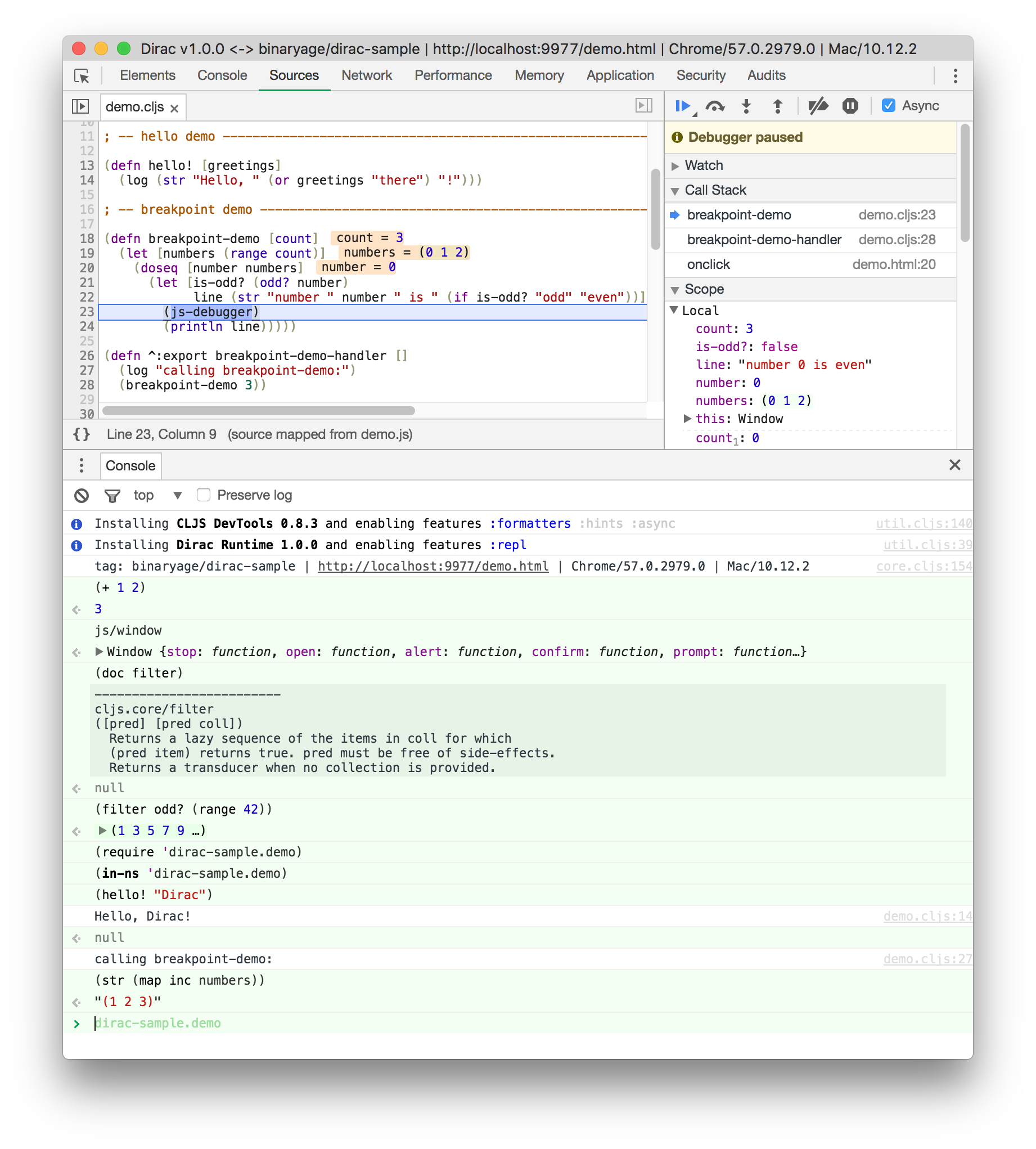Please use Dirac integration examples in
https://github.com/binaryage/dirac/tree/master/examples
This project is an example of integration of Dirac DevTools into a Leiningen-based ClojureScript project.
git clone https://github.com/binaryage/dirac-sample.git
cd dirac-sample
Launch latest Chrome Canary from command-line. I recommend to run it with a dedicated user profile, because you will install there a helper Chrome Extension. Also you have to run it with remote debugging enabled on port 9222 (better make an alias of this command):
/Applications/Google\ Chrome\ Canary.app/Contents/MacOS/Google\ Chrome\ Canary \
--remote-debugging-port=9222 \
--no-first-run \
--user-data-dir=.test-dirac-chrome-profile
Now you can install the Dirac DevTools Chrome extension.
After installation, should see a new extension icon next to your address bar .
Now you can launch the demo project from terminal:
lein demo
At this point you should have a demo website running at http://localhost:9977.
Please navigate there, do not open internal DevTools and click Dirac icon while on the http://localhost:9977/demo.html page.
It should open you a new window with Dirac DevTools app.
It will look almost the same as internal DevTools, but you can tell the difference at first glance: active tab highlight
will be green instead of blue (see the screenshots above).
Ok, now you can switch to Javascript Console in Dirac DevTools. Focus prompt field and press CTRL+, or CTRL+..
This will cycle between Javascript to ClojureScript REPL prompts.
You should see a red message on a green background: Dirac Agent is not listening at ws://localhost:8231 (need help?).
That's correct. Dirac REPL uses nREPL protocol so we have to provide it with some nREPL server. Luckily enough leiningen offers nREPL server by simply running (in a new terminal session):
lein repl
The terminal should print something similar to this:
Compiling ClojureScript...
nREPL server started on port 8230 on host 127.0.0.1 - nrepl://127.0.0.1:8230
REPL-y 0.3.7, nREPL 0.2.12
Clojure 1.8.0
Java HotSpot(TM) 64-Bit Server VM 1.8.0_60-b27
Docs: (doc function-name-here)
(find-doc "part-of-name-here")
Source: (source function-name-here)
Javadoc: (javadoc java-object-or-class-here)
Exit: Control+D or (exit) or (quit)
Results: Stored in vars *1, *2, *3, an exception in *e
user=>
Dirac Agent v0.5.0
Connected to nREPL server at nrepl://localhost:8230.
Agent is accepting connections at ws://localhost:8231.
Last three lines ensure you that Dirac Agent was launched alongside your nREPL server. It connected to it and is accepting DevTools connections on the websocket port 8231.
After your Dirac Agent is up your Dirac DevTools should eventually reconnect.
Connected? The red message should go away and you should see cljs.user indicating your
current namespace. REPL is ready for your input at this point. You can try:
(+ 1 2)
js/window
(doc filter)
(filter odd? (range 42))
If you see something very similar to the first screenshot at the top, you have Dirac running properly.
Congratulations!
Let's try to call hello! function from our namespace dirac-sample.demo.
(dirac-sample.demo/hello! "World")
It worked "Hello, World!" was logged into the console (white background means that the logging output originated in Javascript land).
As you probably know you should first require (or eval) namespace in the REPL context to make it aware of namespace content.
(require 'dirac-sample.demo)
But still you have to type fully qualified name because currently you are in cljs.user namespace. To switch you can use in-ns special function.
Let's try it:
(in-ns)
You get an error java.lang.IllegalArgumentException: Argument to in-ns must be a symbol.. This is a Java exception from nREPL side.
Execute (doc in-ns) to see the documentation for this special REPL function. It expects namespace name as the first argument.
(in-ns 'dirac-sample.demo)
(hello! "Dirac")
Should log Hello, Dirac! into the console without warnings.
You can also test evaluation of ClojureScript in the context of selected stack frame when paused on a breakpoint:
- click the "demo a breakpoint" button on the page
- debugger should pause on the
(js-debugger)line in the breakpoint-demo function
Custom formatters should be presented as inlined values in the source code. Also property names in the scope panel are sorted and displayed in a more friendly way.
Now hit ESC to bring up console drawer. Make sure you are switched to Dirac REPL and then enter:
numbers
You should see actual value (0 1 2) of the numbers variable from local scope (formatted by custom formatters from cljs-devtools).
Same way as you would expect when evaluating a Javascript command in a breakpoint context. Actually you can try it.
Hit CTRL+. to switch to Javascript console prompt (white background) and enter:
numbers
This should return the same output.
And now return back to Dirac REPL by pressing CTRL+. again and enter:
(str (map inc numbers))
You should get back a string "(1 2 3)".
This is a proof that Dirac REPL can execute arbitrary ClojureScript code in the context of a selected stack frame.

